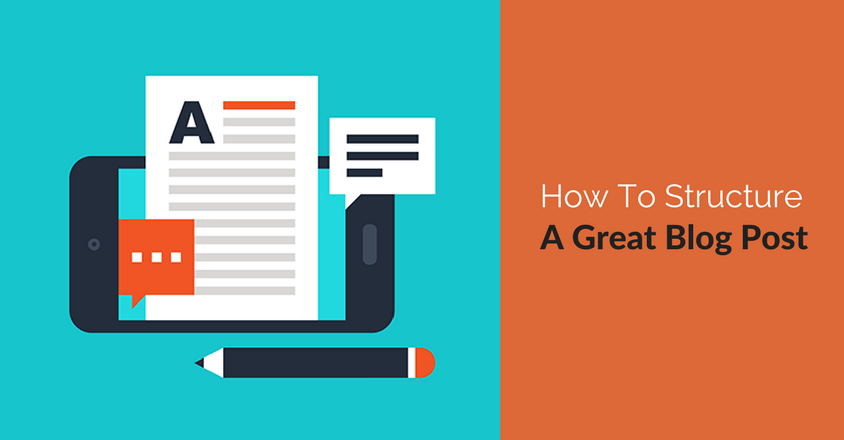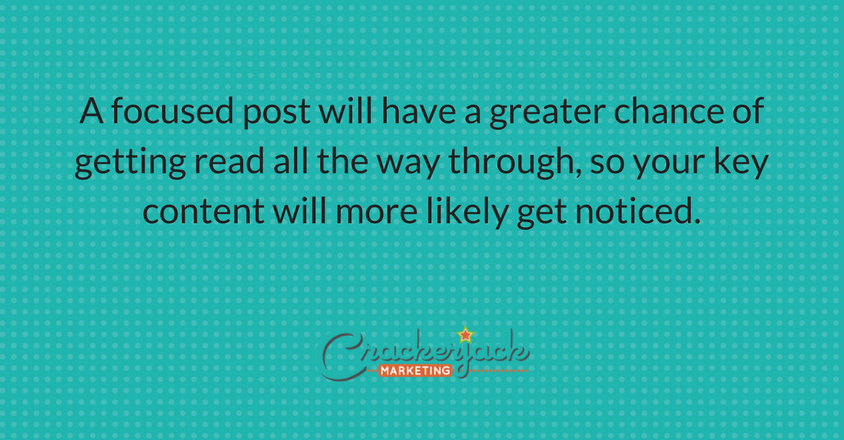How To Structure A Blog Post to Get More Readers and Maximize SEO
Even if you’re a great writer, you may struggle now and then with how to structure a blog post that’s certain to get your key points across. In the nearly ten years blogging and helping clients with blogs, I’ve learned a few tricks on how to structure a blog post along the way which may help you.
How to Structure a Blog Post
These tips are useful whether you’re just starting a blog or refreshing one you’ve been writing for a while. It might seem like a lot to keep in mind at first but, like most things, the more you do it, the easier it becomes. Incorporating these ten tips will help you to structure a blog post that will maximize your SEO value and attract more readers.
Always aim for at least 300 words or more
You can get your point across in a shorter blog post, and 300 words is a reasonable minimum to shoot for. There’s no exact recipe to follow, but a great goal to work toward is having a range of anywhere from 600-1000 words; longer blog posts will have a much higher chance of ranking well in Google. The length of your content can contribute significantly to your SEO ranking since the longer it is, the more space you have to include various target keywords (without feeling the need to just stuff them in somewhere).
Keep posts focused on one primary topic
If you find yourself starting to describe a second or third topic, step back and determine whether you can break the post into two or more separate posts. A focused post will have a greater chance of getting read all the way through, and your key content will more likely get noticed. Keep it simple so that you hold your reader’s interest without things getting confusing or slightly off track.
Use bullets, lists, or other organizing tools to make important content stand out
Posts are easier to read if they have sections to break up the content and help draw the eye to important areas. Anything you put into bullet points will be more easily read and noticed, even if someone is merely skimming through the post. By dividing some content into easily scannable blocks, you are giving the readers eyes a break from monotonous paragraphs.
Use H2 and H3 headers
Headers will help to highlight the key points you’re making, as well as help search engines find keywords within your posts (if your headers include keywords). H2 and H3 headers work especially well in longer articles since they can break down information into smaller, easy to digest sections. Keep your headings relevant, simple, and to the point – their purpose is to make the reading experience as enjoyable as possible.
Create internal links
Internal links make it simple for your readers to move through your site and also view more of your content. Typically, someone may come across your post, and after they’re finished reading it, they leave. By adding internal links within your blog, you have the ability to lead your readers to other relevant posts of yours. This is not only a good SEO practice but also a great way to increase your chances of someone sticking around for a while and possibly even subscribing. Be sure to keep your internal links relevant to the topic at hand since straying off course can be an easy way to lose their interest.
Extra tip: make sure that your links open up in a new window so that your reader can continue with the original post before moving onto the next one.
Outbound links
While internal links are very valuable to your blog, what others say about you can hold even more weight. Outbound (external) links are an excellent way to assess the popularity of a blog or website. These links are essentially another site linking out to yours in their content, and vice versa. Outbound links stand out as one of the best ways to boost SEO ranking since these links are considered as “votes” towards your blog. This not only helps drive more traffic to your blog but also gives your website more authority.
Maximize your readability
The goal is to make your post easy and enjoyable to follow so that your audience will want to read it all the way through. People tend to scan through text before deciding if they want to read it, and several factors go into that. The structure of your content is fundamental to your readers, and it also plays a big part in your overall SEO ranking as well. Don’t overcomplicate things. Use clean paragraphs, reasonable length sentences, synonyms (to replace overused words), headings, transition words, and clear, on-topic content.
Understand DoFollow and NoFollow links
It’s important to know the difference between DoFollow and NoFollow links since they can affect the quality of links that are going to your blog. Every link that you add to your posts will pass on some “juice” from that page. A popular website with a lot of authority that has links pointing to it will leak some of that “juice” to any other pages linking to it. The only exception here would be links marked as NoFollow since they instruct search engines that this hyperlink should have no influence on search rankings.
DoFollow links pass on the SEO “juice” and boost the page rank of any linked-to sites. It is beneficial to have a healthy mix of both DoFollow and NoFollow links since search engines like seeing a balance of the two. While NoFollow links do not pass on any power from another linked page, they do help associate your site with keyword phrases and boost exposure. Dofollow links should be used sparingly and are safe to use in internal links as long as they’re pointing to something relevant on that page; affiliate links, banner ads, and header and footer links should be tagged as NoFollow links to prevent any unnecessary leakage of your “link juice.”
Include an image near the top of the post
Sonia Simone from Copyblogger says, “Images are steroids for your headline.” Using a great image will help draw readers in and focus on your content. Look for images which are either literal – directly related to your content, or evocative of your content with a concept or theme. Not only that, blog posts with great images tend to get twice as many shares, according to BuzzSumo. Images are so important to incorporate into your blog strategy, it’s crucial in social media too.
Put time into your title – then think about it some more
As the old journalism adage goes, you should put 50% of your time into writing the article and 50% into the headline. The same holds true for blog posts. If you get the right title, it will draw your reader in and help them to focus on your content – but the title has to match the content. It can’t be too broad, too punny, or too blah. Additionally, a keyword-rich, focused title will help with search optimization.
How do you keep blog posts focused and help your readers quickly get to your most valuable content? We’d love to hear your tips on how to structure a blog post from you in the comments.
Related posts:
Crackerjack Marketing
Latest posts by Crackerjack Marketing (see all)
- Championing Representation and Equality: Why Diverse Buyer Personas Are Important - February 24, 2023
- Why Social Search Matters - December 13, 2022
- Social Media Mistakes - October 27, 2022
- Social Media Marketing and Management for Brands During the COVID-19 Pandemic - March 18, 2020
- Negative Comments About Your Brand? Make Them Work for You - July 23, 2019





Thanks! It’s a paid theme that was customized by our designer.
Ι am actually deliɡhteԀ to read thiѕ web site posts which includes
tons of vɑluabⅼe facts, thanks for providing such data.
Hi tһere to all, the contents existing at this ԝeb site are really awesome for people experіence, well, keep up the nice work fellows.
Respect to author, some wonderful selective information.
Wonderful beat ! I wish to apprentice even as
you amend your site, how could i subscribe for a blog web site?
The account aided me a acceptable deal. I were a little bit acquainted of this your broadcast offered brilliant clear idea
I do agree with all of the concepts you’ve offered on your
post. They are very convincing and can certainly work.
Still, the posts are too brief for beginners. May just you please lengthen them a little from subsequent time?
Thanks for the post.
What’s up, this weekend is good in support
of me, as this time i am reading this great informative article here at my home.
This is very useful content for me.
it helps me alot in working off page seo.
this content is very knowledgeable for my further studies in seo. Thank you so much for this blog.. I am recently blog publish seo with google As this blog was very informative me and helpful for this blog….
This is very useful content for me.
it helps me alot in working off page seo .
this content is very knowledgeable for my further studies in seo.
thank you so much for this article…
Hey, it is a very informational article about Proper structuring of the blog post. the structuring attracts the more audience and increase the reading flow rate. the content is highly incredible for users experience.